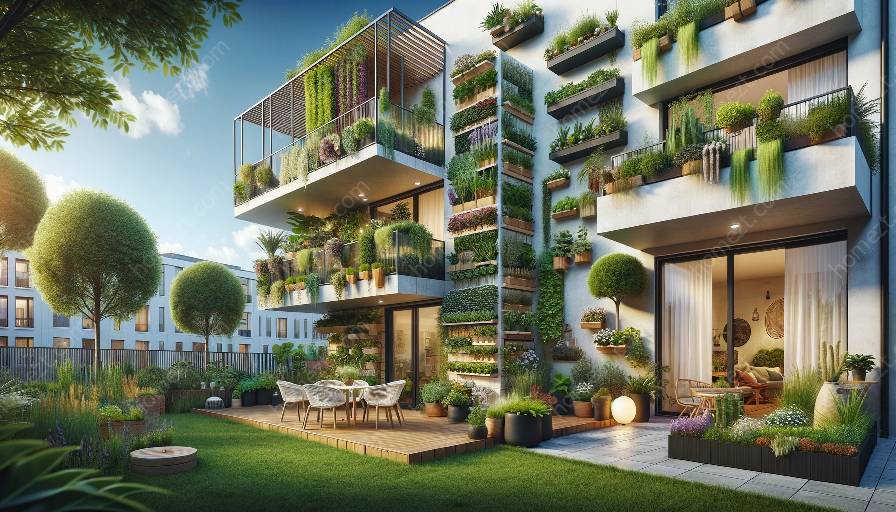Welcome to our comprehensive guide to designing and planning an urban garden. In this article, we will explore the principles and strategies for creating a beautiful and functional outdoor space in an urban setting, suitable for urban gardening, as well as being ideal for yards and patios.
Understanding Urban Gardening
As urbanization continues to grow, the concept of urban gardening has gained popularity. Urban gardening refers to the practice of cultivating, maintaining, and designing gardens in urban areas. It encompasses a wide range of gardening practices, from traditional soil-based gardening to innovative vertical and container gardening techniques.
Urban gardening offers numerous benefits, including access to fresh produce, enhanced community engagement, and the creation of green spaces in urban environments. When designing an urban garden, it's crucial to consider the unique challenges and opportunities that come with gardening in a limited space within a city.
Principles of Designing an Urban Garden
The key to successful urban garden design lies in creating a harmonious balance between aesthetics, functionality, and sustainability. Urban gardens should be thoughtfully planned to maximize the use of available space and resources, while also promoting biodiversity and environmental stewardship.
1. Assessing Your Space
Before diving into the design process, it's essential to assess the available space for your urban garden. Consider the size, orientation, and existing features of your yard or patio. Understanding these elements will help you make informed decisions about plant selection, layout, and infrastructure.
2. Establishing Goals and Priorities
Define your goals and priorities for the urban garden. Are you primarily interested in growing edible plants, creating a tranquil retreat, or supporting local wildlife? Setting clear objectives will guide the design process and ensure that the garden aligns with your vision.
3. Functional Layout and Zones
Divide the garden into functional zones, such as seating areas, edible gardens, and ornamental plantings. Each zone should serve a specific purpose while seamlessly integrating with the overall design. Consider pathways, focal points, and access points to optimize the flow and usability of the space.
4. Sustainable Practices
Integrate sustainable practices into your urban garden design, such as water-efficient irrigation systems, composting bins, and the use of native plants. Emphasize resource conservation and eco-friendly techniques to minimize the garden's environmental impact.
Planning and Implementation
Once the design concept is established, transitioning to the planning and implementation phase is critical. This involves selecting appropriate plants, materials, and structures, as well as defining maintenance routines and care protocols.
1. Plant Selection
Choose plant species that are well-suited to the urban environment, considering factors such as sunlight exposure, soil quality, and climate conditions. Incorporate a diverse mix of plants to create visual interest and support local biodiversity.
2. Hardscaping and Infrastructure
Integrate hardscaping elements, such as raised beds, trellises, and seating, to enhance the functionality and visual appeal of the garden. Select durable, low-maintenance materials that complement the overall design and withstand urban conditions.
3. Maintenance and Care
Develop a maintenance plan that outlines watering schedules, fertilization routines, and pest management strategies. Regular monitoring and upkeep are essential for the long-term health and vitality of the urban garden.
Urban Garden Inspiration
To inspire your urban garden design, consider exploring various design styles and themes that resonate with urban living. From modern and minimalist designs to lush and vibrant retreats, urban gardens can be tailored to reflect personal preferences and lifestyle choices.
1. Vertical Gardens
Vertical gardens offer space-saving solutions for urban environments, allowing plants to flourish on walls and vertical structures. These gardens can serve as living art installations and provide insulation and cooling benefits to buildings.
2. Container Gardening
Container gardening is ideal for small urban spaces, enabling individuals to grow plants in pots, planters, and other containers. This versatile approach allows for mobility and flexibility in garden design, catering to various preferences and constraints.
3. Pollinator Gardens
Creating a pollinator-friendly garden promotes ecological balance and supports the health of local bee and butterfly populations. By incorporating nectar-rich flowers and habitat features, urban gardeners can contribute to the preservation of crucial pollinator species.
Conclusion
Designing and planning an urban garden is a rewarding endeavor that blends creativity, environmental stewardship, and community engagement. By embracing the principles of sustainable design and leveraging innovative gardening techniques, urban gardeners can transform urban spaces into vibrant, productive, and inviting landscapes. Whether you have a small patio or a spacious yard, the art of urban gardening offers endless possibilities for creating lush, thriving outdoor havens within the urban fabric.


